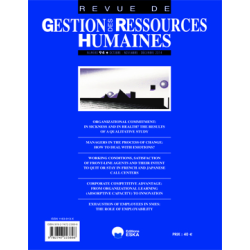


Résumé
Cette étude sintéresse à lapprentissage organisationnel appréhendé à laide du concept de capacité dabsorption et à linnovation car la vélocité de lenvironnement dans lequel évoluent, de nos jours, les entreprises fait que ces dernières se doivent dinnover afin de rester compétitives. Cette recherche étudie donc, plus particulièrement, au moyen de données quantitatives récoltées auprès de 2547 firmes, premièrement le rôle de lapprentissage organisationnel sur linnovation et, deuxièmement examine si la combinaison apprentissage organisationnel-innovation conduit la firme à posséder un avantage concurrentiel. Les résultats obtenus nous permettent davancer que lapprentissage organisationnel joue un rôle primordial sur linnovation. de même, la combinaison apprentissage organisationnel-innovation permet à la firme dêtre compétitive sur le marché.
Mots-clés : innovation, capacité dabsorption, connaissance, apprentissage organisationnel.